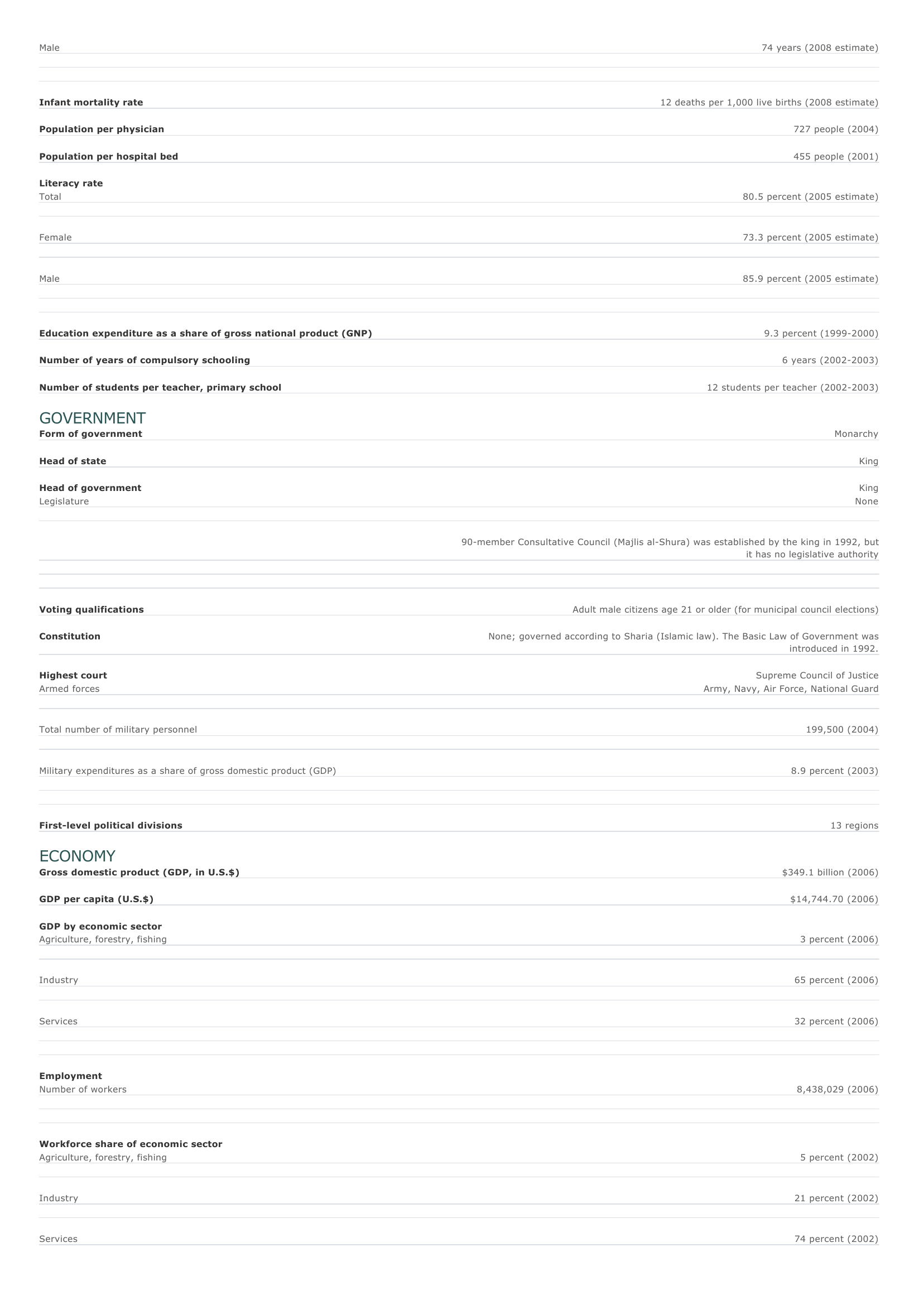Saudi Arabia Facts and Figures. BASIC FACTS Official name Capital Area Kingdom of Saudi Arabia Riyadh 2,240,000 sq km 864,900 sq mi PEOPLE Population 28,161,417 (2008 estimate) Population growth Population growth rate 1.95 percent (2008 estimate) Projected population in 2025 35,668,686 (2025 estimate) Projected population in 2050 49,706,851 (2050 estimate) Population density 13 persons per sq km (2008 estimate) 34 persons per sq mi (2008 estimate) Urban/rural distribution Share urban 88 percent (2005 estimate) Share rural 12 percent (2005 estimate) Largest cities, with population Riyadh 5,126,000 (2003 estimate) Jiddah 2,801,481 (2004 estimate) Mecca (Makkah) 1,294,168 (2004 estimate) Medina 918,889 (2004 estimate) Ethnic groups Arab (including Yemeni) O ther 95 percent 5 percent Languages Arabic (official), English (for business) Religious affiliations Muslim (official, mostly Sunni Muslim) 94 percent Christian 3 percent Hindu 1 percent O ther 2 percent HEALTH AND EDUCATION Life expectancy Total 76.1 years (2008 estimate) Female 78.2 years (2008 estimate) Male Infant mortality rate 74 years (2008 estimate) 12 deaths per 1,000 live births (2008 estimate) Population per physician 727 people (2004) Population per hospital bed 455 people (2001) Literacy rate Total 80.5 percent (2005 estimate) Female 73.3 percent (2005 estimate) Male 85.9 percent (2005 estimate) Education expenditure as a share of gross national product (GNP) Number of years of compulsory schooling Number of students per teacher, primary school 9.3 percent (1999-2000) 6 years (2002-2003) 12 students per teacher (2002-2003) GOVERNMENT Form of government Head of state Head of government Legislature Monarchy King King None 90-member Consultative Council (Majlis al-Shura) was established by the king in 1992, but it has no legislative authority Voting qualifications Constitution Highest court Armed forces Total number of military personnel Military expenditures as a share of gross domestic product (GDP) First-level political divisions Adult male citizens age 21 or older (for municipal council elections) None; governed according to Sharia (Islamic law). The Basic Law of Government was introduced in 1992. Supreme Council of Justice Army, Navy, Air Force, National Guard 199,500 (2004) 8.9 percent (2003) 13 regions ECONOMY Gross domestic product (GDP, in U.S.$) GDP per capita (U.S.$) $349.1 billion (2006) $14,744.70 (2006) GDP by economic sector Agriculture, forestry, fishing 3 percent (2006) I ndustry 65 percent (2006) Services 32 percent (2006) Employment Number of workers 8,438,029 (2006) Workforce share of economic sector Agriculture, forestry, fishing 5 percent (2002) I ndustry 21 percent (2002) Services 74 percent (2002) Unemployment rate 6.2 percent (2006) National budget (U.S.$) Total revenue Not available Total expenditure Not available Monetary unit 1 Saudi riyal (SR), consisting of 100 halalah Agriculture Wheat, dates, tomatoes, watermelons, barley, sorghum, onions, grapes, citrus fruit; dairy products, poultry Mining Petroleum, natural gas, limestone, gypsum, marble, clay, salt, gold Manufacturing Refined petroleum, petrochemicals, plastics, processed food, clothing, fertilizer, cement Major exports Crude and refined petroleum, petrochemicals Major imports Transportation equipment, machinery, basic metals, textiles, chemicals, and chemical products, food products, animals and animal products Major trade partners for exports United States, Japan, South Korea, Singapore, and Taiwan Major trade partners for imports United States, Japan, Germany, United Kingdom, and Italy ENERGY, COMMUNICATIONS, AND TRANSPORTATION Electricity production Electricity from thermal sources 100 percent (2003 estimate) Electricity from hydroelectric sources 0 percent (2003 estimate) Electricity from nuclear sources 0 percent (2003 estimate) Electricity from geothermal, solar, and wind sources 0 percent (2003 estimate) Number of radios per 1,000 people 321 (1997) Number of telephones per 1,000 people 164 (2005) Number of televisions per 1,000 people 256 (2000 estimate) Number of Internet hosts per 10,000 people Daily newspaper circulation per 1,000 people Number of motor vehicles per 1,000 people Paved road as a share of total roads 7 (2003) 59 (1996) 151 (1997) 30 percent (2000) SOURCES Basic Facts and People sections Area data are from the statistical bureaus of individual countries. Population, population growth rate, and population projections are from the United States Census Bureau, International Programs Center, International Data Base (IDB) (www.census.gov). Urban and rural population data are from the Food and Agriculture Organization (FAO) of the United Nations (UN), FAOSTAT database (www.fao.org). Largest cities population data and political divisions data are from the statistical bureaus of individual countries. Ethnic divisions and religion data are largely from the latest Central Intelligence Agency (CIA) World Factbook and from various country censuses and reports. Language data are largely from the Ethnologue, Languages of the World, Summer Institute of Linguistics International (www.sil.org). Health and Education section Life expectancy and infant mortality data are from the United States Census Bureau, International Programs Center, International database (IDB) (www.census.gov). Population per physician and population per hospital bed data are from the World Health Organization (WHO) (www.who.int). Education data are from the United Nations Educational, Scientific and Cultural Organization (UNESCO) database (www.unesco.org). Government section Government, independence, legislature, constitution, highest court, and voting qualifications data are largely from various government Web sites, the latest Europa World Yearbook, and the latest Central Intelligence Agency (CIA) World Factbook. The armed forces data is from Military Balance. Economy section Gross domestic product (GDP), GDP per capita, GDP by economic sectors, employment, and national budget data are from the World Bank database (www.worldbank.org). Monetary unit, agriculture, mining, manufacturing, exports, imports, and major trade partner information is from the statistical bureaus of individual countries, latest Europa World Yearbook, and various United Nations and International Monetary Fund (IMF) publications. Energy, Communication, and Transportation section Electricity information is from the Energy Information Administration (EIA) database (www.eia.doe.gov). Radio, telephone, television, and newspaper information is from the United Nations Educational, Scientific and Cultural Organization (UNESCO) database (www.unesco.org). Internet hosts, motor vehicles, and road data are from the World Bank database (www.worldbank.org). Note Figures may not total 100 percent due to rounding. Microsoft ® Encarta ® 2009. © 1993-2008 Microsoft Corporation. All rights reserved.





